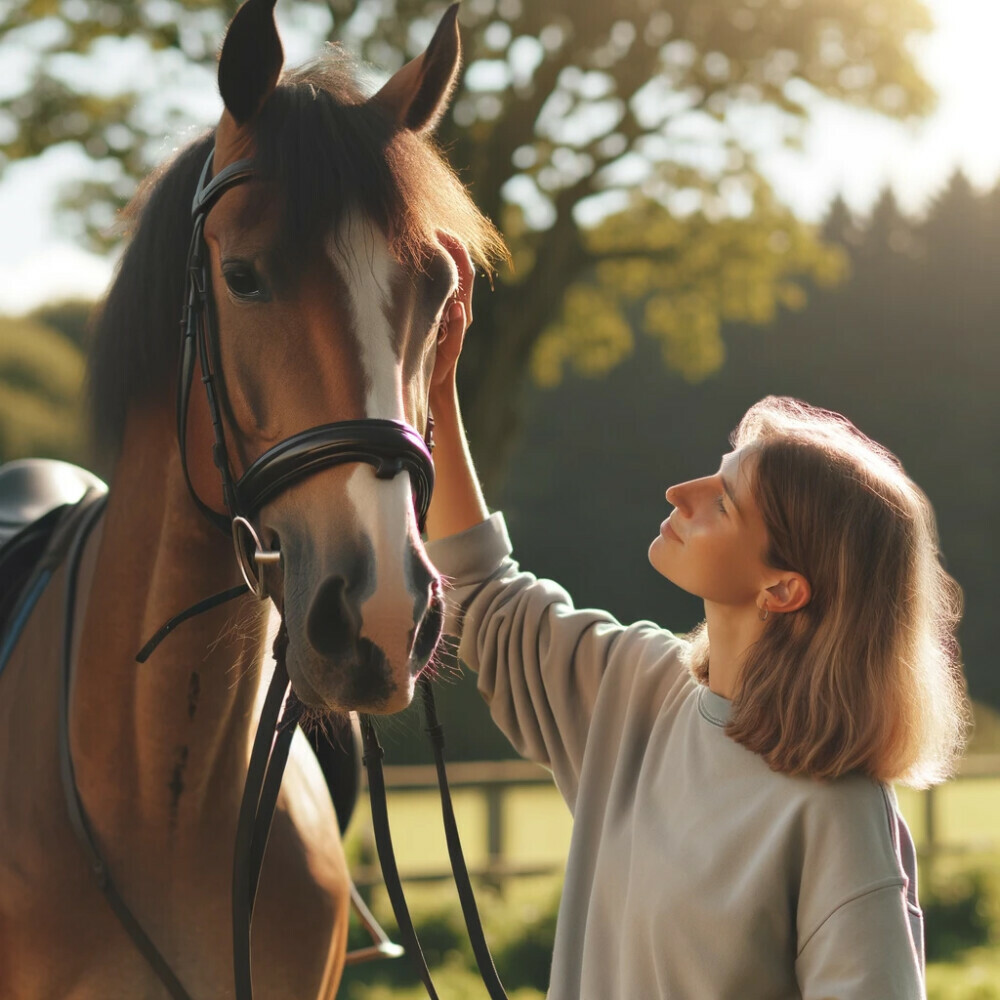Building a Relationship Based on Trust and Respect
Trust and respect form the core of a successful training relationship with your horse. Just like in any meaningful human relationship, these elements take time, effort, and a consistent approach to develop. With time and effort you can make a great connection with your horse. Here are some detailed strategies to help you build a strong, trust-based relationship with your horse:
1. Spend Quality Time Together

Spending time with your horse outside of training sessions is crucial. This time allows you to get to know each other in a relaxed setting, free from the pressures of structured training. Here are some activities to consider:
- Grooming Sessions: Regular grooming helps your horse associate your presence with a positive experience. It’s also a great opportunity to check for any health issues and strengthen your bond. You can get some really good grooming kits.
- Hand-Walking: Taking your horse for a walk around the paddock or stable yard allows them to explore their environment with you by their side. It’s a low-stress way to build familiarity and trust.
- Quiet Time: Simply spending time in your horse’s presence, such as sitting in their pasture or stall, can help them become more comfortable and confident around you.
2. Consistency is Key
Consistency in your actions, commands, and routines helps your horse understand what to expect from you, reducing anxiety and building trust. Here’s how to ensure consistency:
- Routine: Establish a regular schedule for feeding, grooming, and training. Horses thrive on routine, and knowing what to expect can make them feel secure.
- Commands: Use the same cues and commands consistently. Mixed signals can confuse your horse and undermine your training efforts.
- Behavior: Always react in a predictable manner. If your horse knows that you will respond calmly and consistently to their actions, they will feel more secure and confident.
3. Patience is Essential
Building trust with a horse requires patience. Each horse is different, and some may take longer to trust than others. Here are some tips for practicing patience:
- Progress at Their Pace: Allow your horse to progress at a pace they are comfortable with. Pushing them too hard or too fast can lead to resistance and fear.
- Stay Calm: Horses are sensitive to emotions. Staying calm and composed, even when your horse is not cooperating, will help them feel safe.
- Celebrate Small Wins: Acknowledge and reward even the smallest signs of progress. This positive reinforcement encourages your horse to keep trying and builds their confidence.
4. Positive Reinforcement

Positive reinforcement involves rewarding your horse for good behavior, which encourages them to repeat those behaviors. This method can significantly enhance your training sessions and your overall relationship. Here’s how to implement positive reinforcement effectively:
- Treats and Praise: Offering treats or verbal praise immediately after your horse performs a desired behavior reinforces that behavior. Be sure to give the reward right away so your horse can make the connection.
- Scratches and Pats: Many horses enjoy being scratched or patted in their favorite spots. Use these as rewards to build a positive association with training.
- Clicker Training: This method involves using a clicker to mark the exact moment your horse performs a desired behavior, followed by a treat. It can be a powerful tool for shaping new behaviors.
5. Gentle and Clear Guidance
Horses respond well to gentle and clear guidance. Being a calm, assertive leader helps your horse feel secure and willing to follow your direction. Here’s how to provide gentle and clear guidance:
- Body Language: Horses are incredibly sensitive to body language. Use calm, deliberate movements to communicate with your horse.
- Voice Commands: Use a soft but firm voice when giving commands. Avoid shouting or harsh tones, as these can frighten or stress your horse.
- Physical Cues: When using physical cues, such as reins or leg pressure, be gentle yet clear. Abrupt or rough handling can damage trust and lead to resistance.
6. Respect Your Horse’s Individuality

Every horse has a unique personality and set of experiences. Understanding and respecting your horse’s individuality is key to building trust and respect. Here’s how to honor your horse’s unique traits:
- Learn Their Preferences: Pay attention to what your horse likes and dislikes. Some horses may enjoy certain activities or types of rewards more than others.
- Adapt Your Approach: Be willing to adjust your training methods to suit your horse’s temperament and learning style. Flexibility shows your horse that you are attuned to their needs.
- Acknowledge Their History: If your horse has a past that includes trauma or negative experiences, be extra patient and gentle. Understanding their history can help you address any behavioral issues with empathy.
Conclusion
Building a relationship with your horse based on trust and respect is a rewarding journey that enhances both your lives. By spending quality time together, being consistent, practicing patience, using positive reinforcement, providing gentle and clear guidance, and respecting your horse’s individuality, you can foster a deep, cooperative partnership. This foundation of trust and respect not only improves your training outcomes but also creates a harmonious bond that enriches your equine experience. Remember, the journey of building this relationship is just as important and fulfilling as the destination.

